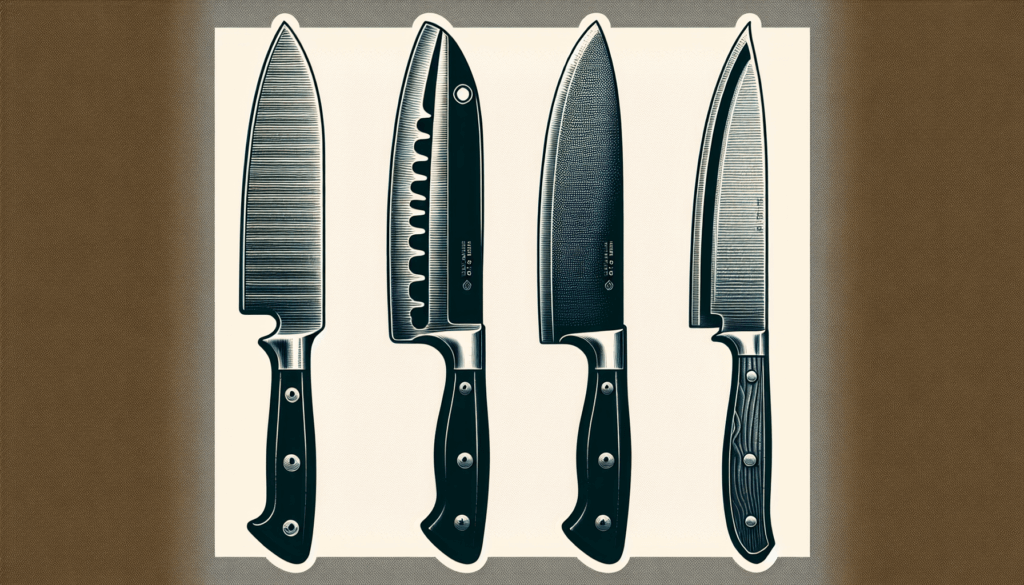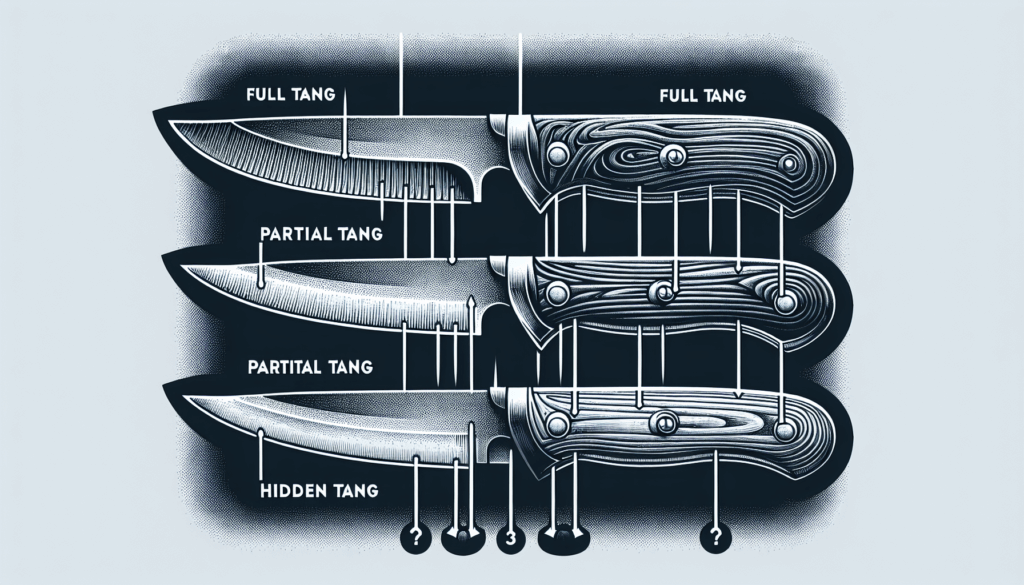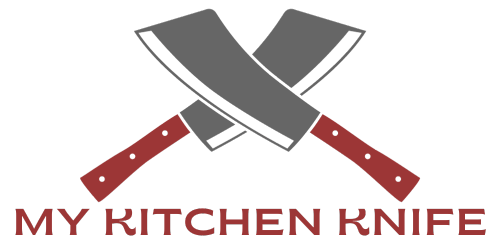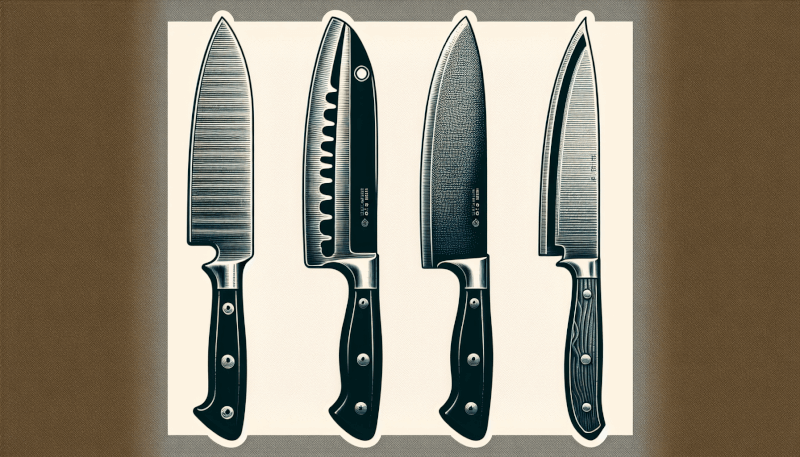Today, we’ll explore the fascinating world of kitchen knife tangs and discover the numerous benefits they offer. If you’ve ever wondered about the various types of tangs found in kitchen knives and how they can enhance your cooking experience, you’re in for a treat. From hidden tangs to full tangs, each type brings unique advantages to the table. So, let’s grab our aprons and dive into the realm of kitchen knife tangs to uncover their secrets and understand why they matter in your culinary adventures.

Full Tang
Definition
A full tang is a type of knife tang where the metal extends the entire length and width of the handle, allowing the handle to be securely fastened on both sides. This design creates a strong and sturdy knife that ensures optimal balance and durability.
Advantages
The full tang construction offers several advantages. Firstly, it provides superb balance, allowing you to have better control over the knife while cutting or chopping. This balance is especially crucial when handling larger and heavier knives.
Secondly, the full tang design ensures exceptional durability. With the metal running through the handle, the knife is less likely to break or separate from the handle even under heavy use. This is particularly important for professional chefs or avid home cooks who require knives that can withstand rigorous tasks.
Another advantage is that full tang knives offer better stability and reduced vibration. This means that you won’t experience the handle wobbling or the blade rattling during use, providing a more comfortable and controlled cutting experience.
Lastly, full tang knives are typically easier to maintain and repair. With the handle securely attached on both sides, you can easily replace the handle if it becomes damaged or worn out, extending the overall lifespan of the knife.
Disadvantages
While full tang knives provide numerous benefits, they do have some minor disadvantages. One potential drawback is that due to the extra metal in the handle, full tang knives are generally heavier than other types of tangs. This extra weight may be noticeable during extended periods of use, especially for those with weaker wrists or hands.
Additionally, full tang knives may be more expensive compared to knives with other tang types. This is due to the higher amount of metal used in their construction and the added craftsmanship required to create a seamless and secure attachment between the tang and the handle.
Overall, the advantages of a full tang knife outweigh the disadvantages, making it a highly desirable choice for both professional chefs and home cooks who prioritize durability and performance in their kitchen tools.
Partial Tang
Definition
A partial tang refers to a type of knife tang where the metal does not extend the full length of the handle. Instead, it only runs partially into the handle, stopping before reaching the far end. This construction may vary in design, but it generally provides less stability and durability compared to a full tang knife.
Advantages
Partial tang knives have some advantages that cater to specific needs. One advantage is that they are often lighter than full tang knives. This lighter weight can be beneficial for those who prefer a nimble and agile knife, especially when performing intricate tasks that require precision and dexterity.
Another advantage of partial tang knives is their affordability. With less metal used in the construction, these knives tend to be more cost-effective compared to their full tang counterparts. This makes them a suitable option for those on a limited budget who still want a functional and reliable kitchen knife.
Disadvantages
Partial tang knives do have some drawbacks that need to be considered. One of the main disadvantages is their reduced stability and durability. The limited metal in the handle means that the knife may be more susceptible to breakage, especially under heavy use or forceful cutting motions. This can be a significant concern for professional chefs or those who frequently engage in demanding culinary tasks.
Additionally, partial tang knives may not offer the same level of balance and control as full tang knives. The distribution of weight may be uneven, resulting in a knife that feels less stable in hand. This can make it more challenging to maintain control and precision while cutting or chopping.
In conclusion, partial tang knives may be suitable for individuals who prioritize lightness and affordability, but they may not provide the same level of durability and stability as full tang knives.
Encapsulated Tang
Definition
An encapsulated tang refers to a type of knife tang where the metal extends the entire length of the handle, similar to a full tang. However, unlike a full tang, an encapsulated tang is covered or enclosed within the handle material.
Advantages
Encapsulated tang knives offer a blend of the stability provided by a full tang and the aesthetics of a hidden tang. One key advantage of this design is that it provides excellent strength and durability, ensuring that the knife can handle rigorous tasks without compromising its structural integrity.
Another advantage is the enhanced aesthetics. By encasing the tang within the handle material, the knife has a sleek and seamless appearance. This can be particularly appealing for those who appreciate a visually appealing and well-crafted kitchen tool.
Encapsulated tang knives also offer improved hygiene. With the tang fully enclosed, there are no gaps or exposed metal for food particles or liquids to get trapped in. This makes them easier to clean and maintain, reducing the risk of contamination and ensuring a safe food preparation environment.
Disadvantages
One potential disadvantage of encapsulated tang knives is that they can be more challenging to repair if the handle becomes damaged or worn out. Unlike full tang knives where the handle can be easily replaced, the encapsulated tang requires more intricate and specialized techniques to repair or replace the handle.
Additionally, encapsulated tang knives may be slightly heavier than knives with other tang types due to the additional materials used to encase the tang. This may affect the overall balance and feel of the knife, potentially requiring some adjustment for those accustomed to lighter knives.
In summary, encapsulated tang knives offer a combination of strength, aesthetics, and hygiene. While they may be slightly more challenging to repair, their overall performance and visual appeal make them a popular choice among kitchen enthusiasts.
Hidden Tang
Definition
A hidden tang is a type of knife tang where the metal extends the full length of the handle but is not visible from the outside. The tang is inserted into a recess within the handle material, making it completely hidden from view.
Advantages
Hidden tang knives offer several advantages that make them a preferred choice among knife enthusiasts. Firstly, the hidden tang design allows for greater customization and variety in handle materials and designs. With the tang concealed, the handle can be crafted from a wide range of materials, including wood, bone, or synthetic composites, without affecting the knife’s structural integrity.
Additionally, hidden tang knives often provide excellent balance. The distribution of weight along the length of the knife allows for better control and maneuverability during use. This makes them ideal for tasks that require delicate handling or fine precision.
Furthermore, hidden tang knives are generally lighter than full tang knives, making them easier to handle for extended periods without causing fatigue or strain. The reduced weight also increases the knife’s agility, allowing for quick and precise movements.
Disadvantages
One potential disadvantage of hidden tang knives is their reduced overall strength compared to full tang knives. The absence of a visible metal extension beyond the handle may compromise the knife’s durability, especially when subjected to significant force or heavy use.
Additionally, hidden tang knives may be more challenging to repair if the handle becomes damaged or worn out. The concealed nature of the tang requires more specialized techniques to disassemble and reattach a new handle compared to other tang types.
In conclusion, hidden tang knives offer versatility in handle materials and customized designs. While they may have slightly less durability than full tang knives, their excellent balance and lightweight nature make them an attractive option for those seeking precision and agility in their kitchen knives.

Rat-Tail Tang
Definition
A rat-tail tang is a type of knife tang that narrows down at the end, resembling the shape of a rat’s tail. The metal extends into the handle, but it is significantly thinner than the blade, and it does not provide as much stability and durability as other tang types.
Advantages
Rat-tail tang knives have some advantages that cater to specific needs. One advantage is their lightweight and slender design. This makes them easy to handle and maneuver, especially for tasks that require finesse and delicate control.
Another advantage of rat-tail tang knives is their affordability. Thanks to their simpler construction and less metal used, they are often more cost-effective compared to other tang types. This makes them a suitable choice for beginner cooks or those on a tight budget.
Disadvantages
Despite their advantages, rat-tail tang knives have significant disadvantages that should be considered. The main drawback is their lack of stability and durability. The thin metal extension into the handle makes these knives more prone to breakage, especially when subjected to heavy use or forceful cutting motions.
Furthermore, rat-tail tang knives may have imbalanced weight distribution, which can affect the overall control and precision during cutting or chopping. This can be particularly concerning for those who require a stable and reliable knife for challenging culinary tasks.
In summary, while rat-tail tang knives may be suitable for those who prioritize affordability and lightweight design, they may not offer the same level of durability and stability as other tang types, making them less desirable for professional chefs or heavy-duty kitchen use.
Push Tang
Definition
A push tang is a type of knife tang that extends into the handle in a straight line, typically near the center. The metal is narrower than the blade and does not provide as much stability and durability as a full tang or other tang types.
Advantages
Push tang knives offer some advantages that cater to specific needs. One advantage is their lightweight design, which makes them easy to handle and maneuver. This is particularly useful for tasks that require precision and agility, such as slicing, mincing, or decorating.
Another advantage is their affordability. Push tang knives are often more cost-effective compared to other tang types due to their simpler construction and reduced metal usage. This makes them a suitable choice for those on a budget or beginner cooks looking for a reliable kitchen tool.
Disadvantages
One significant disadvantage of push tang knives is their reduced stability and durability. The metal extension into the handle is narrower than the blade, making them more susceptible to breakage under heavy use or forceful cutting motions.
Additionally, push tang knives may have imbalanced weight distribution, affecting the overall control and performance during use. This imbalance can be particularly noticeable for larger or heavier knives, which may require additional force to achieve desired results.
In conclusion, while push tang knives may be suitable for those who prioritize lightweight design and affordability, they may not offer the same level of stability and durability as other tang types. It is important to consider the tasks and requirements before making a decision.

Stick Tang
Definition
A stick tang, also known as a narrow tang, is a type of knife tang that extends into the handle as a straight, narrow rod. Unlike a full tang or other tang types, the rod is typically narrower than the blade, providing less stability and durability.
Advantages
Stick tang knives offer some advantages that cater to specific needs. One advantage is their lightweight design, which makes them easy to handle and maneuver. This can be beneficial for tasks that require precision and finesse, such as boning, fileting, or detailed slicing.
Another advantage of stick tang knives is their affordability. The simple construction and reduced metal usage make them typically more cost-effective compared to full tang or encapsulated tang knives. This makes them a suitable choice for those looking for a budget-friendly kitchen tool.
Disadvantages
The main disadvantage of stick tang knives is their limited stability and durability. The narrower metal rod does not provide the same level of structural integrity as a full tang or other tang types. This makes the knife more susceptible to breakage, especially during heavy-duty cutting or chopping tasks.
Furthermore, stick tang knives may have imbalanced weight distribution, which can affect the overall control and precision during use. This can be a potential concern when handling larger or heavier knives that require more force to cut through tougher ingredients.
In conclusion, stick tang knives may be suitable for those who prioritize lightweight design and affordability, but they may not offer the same level of stability and durability as other tang types. Consider the intended use and requirements before making a decision.
Partial Enclosed Tang
Definition
A partial enclosed tang, also known as a hidden push tang, combines the characteristics of a hidden tang and a push tang. The metal extends partially into the handle without being fully visible from the outside.
Advantages
Partial enclosed tang knives offer a combination of aesthetics and functionality. One advantage is the improved balance facilitated by the metal extension into the handle. The weight distribution along the tang provides better control and maneuverability, especially during precision tasks.
Another advantage is the enhanced aesthetics. By partially encasing the tang within the handle material, the knife presents a streamlined appearance that maintains a sleek and seamless design. This can be visually appealing to those who appreciate the craftsmanship and visual presentation of their kitchen tools.
Partial enclosed tang knives, like hidden tang knives, are generally lighter than full tang knives, allowing for extended use without causing fatigue. This lightweight design enhances agility, making the knife suitable for intricate tasks that require dexterity.
Disadvantages
One potential disadvantage of partial enclosed tang knives is their reduced overall strength compared to full tang knives. The partial coverage of the tang may compromise the structural integrity of the knife, especially when subjected to significant force or heavy use.
Moreover, the repairability of partial enclosed tang knives may be more challenging compared to full tang knives. The concealed nature of the tang requires specialized techniques to disassemble and reattach a new handle, which may limit repair options.
In conclusion, partial enclosed tang knives offer a balance between aesthetics and functionality. While they may have some limitations in strength and repairability, their balanced weight distribution and pleasing appearance make them an attractive choice for many kitchen enthusiasts.

Skeletonized Tang
Definition
A skeletonized tang, also known as a narrow hidden tang, is a type of knife tang that extends into the handle but is significantly narrower than the blade. It is called “skeletonized” because it may have holes or slots cut out along the length, reducing the overall weight of the knife.
Advantages
Skeletonized tang knives offer several advantages that cater to specific needs. One advantage is their incredibly lightweight design. The removal of excess metal through the use of holes or slots results in a knife that is exceptionally agile and easy to handle. This can be advantageous for tasks that require precision and delicate control.
Another advantage of skeletonized tang knives is their enhanced balance. The reduced weight shifts the knife’s center of gravity closer to the handle, allowing for improved maneuverability and control during use. This can be especially beneficial for intricate culinary techniques that require precise movements.
Additionally, due to their reduced metal content, skeletonized tang knives are often more affordable compared to other tang types. This makes them an excellent option for those on a tight budget who still want a reliable and functional kitchen knife.
Disadvantages
One potential disadvantage of skeletonized tang knives is their decreased strength and durability compared to full tang or other tang types. The removal of excess metal may compromise the knife’s structural integrity, making it more prone to breakage under heavy use or forceful cutting motions.
Moreover, the presence of holes or slots can make cleaning and maintenance more challenging. Food particles or liquid may get trapped in these openings, requiring extra care and thorough cleaning to prevent contamination.
In conclusion, skeletonized tang knives offer exceptional lightweight design, balance, and affordability. While they may have limitations in terms of durability and cleaning, their overall performance and handling make them a popular choice for specific culinary tasks.
Conclusion
In conclusion, the different types of kitchen knife tangs offer unique advantages and disadvantages that should be considered when selecting a knife for your culinary needs.
Full tang knives provide excellent balance, durability, and stability, making them a preferred choice for professional chefs and those who value longevity and performance in their kitchen tools.
Partial tang knives offer lightweight designs and affordability, making them suitable for those who prioritize nimbleness and budget-friendly options.
Encapsulated tang knives combine strength, aesthetics, and hygiene, providing excellent performance and a visually appealing design.
Hidden tang knives enable customization and variety in handle materials while maintaining good balance, making them highly versatile and visually appealing.
Rat-tail tang knives prioritize lightweight design and affordability but may sacrifice stability and durability.
Push tang and stick tang knives offer lightweight options and affordability but may lack stability and durability compared to full tang knives.
Partial enclosed tang knives combine the benefits of hidden tang and push tang designs, offering improved balance and aesthetics.
Skeletonized tang knives excel in agility, balance, and affordability, although they may be less durable and require more careful maintenance.
Each tang type caters to different preferences and requirements. It is essential to consider factors such as intended use, budget, ergonomics, and personal preference when selecting a kitchen knife tang. By understanding the advantages and disadvantages of each type, you can make an informed decision to find the ideal knife that suits your needs and enhances your culinary experience.



